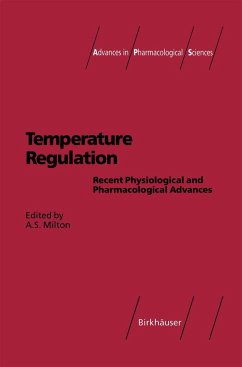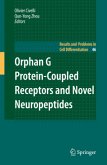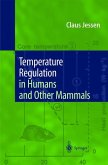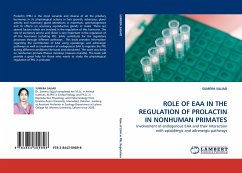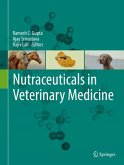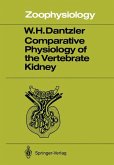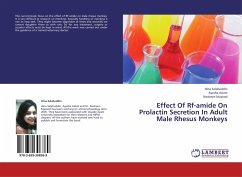Temperature Regulation
Recent Physiological and Pharmacological Advances
Herausgegeben:Milton, A. S.
Temperature Regulation
Recent Physiological and Pharmacological Advances
Herausgegeben:Milton, A. S.
- Gebundenes Buch
- Merkliste
- Auf die Merkliste
- Bewerten Bewerten
- Teilen
- Produkt teilen
- Produkterinnerung
- Produkterinnerung
Many advances have been made in the field of thermoregulation in the past few years. These include our understanding of Fever, which is now considered not simply a rise in deep body temperature foHowing infection, but just one aspect, though perhaps the most easily measured, of the Acute Phase of the Immune Response. Classification and identification of the Cytokines and the availability of recombinant material has greatly aided this research. Similarly, our understanding of the Hypothalamo-Pituitary Adrenal Axis has altered our way of thinking about temperature regulation. Of importance are…mehr
Andere Kunden interessierten sich auch für
![Advances in Disease Vector Research Advances in Disease Vector Research]() Advances in Disease Vector Research81,99 €
Advances in Disease Vector Research81,99 €![Orphan G Protein-Coupled Receptors and Novel Neuropeptides Orphan G Protein-Coupled Receptors and Novel Neuropeptides]() Orphan G Protein-Coupled Receptors and Novel Neuropeptides161,99 €
Orphan G Protein-Coupled Receptors and Novel Neuropeptides161,99 €![Temperature Regulation in Humans and Other Mammals Temperature Regulation in Humans and Other Mammals]() Claus JessenTemperature Regulation in Humans and Other Mammals41,99 €
Claus JessenTemperature Regulation in Humans and Other Mammals41,99 €![ROLE OF EAA IN THE REGULATION OF PROLACTIN IN NONHUMAN PRIMATES ROLE OF EAA IN THE REGULATION OF PROLACTIN IN NONHUMAN PRIMATES]() SUMERA SAJJADROLE OF EAA IN THE REGULATION OF PROLACTIN IN NONHUMAN PRIMATES48,99 €
SUMERA SAJJADROLE OF EAA IN THE REGULATION OF PROLACTIN IN NONHUMAN PRIMATES48,99 €![Nutraceuticals in Veterinary Medicine Nutraceuticals in Veterinary Medicine]() Nutraceuticals in Veterinary Medicine266,99 €
Nutraceuticals in Veterinary Medicine266,99 €![Comparative Physiology of the Vertebrate Kidney Comparative Physiology of the Vertebrate Kidney]() William H. DantzlerComparative Physiology of the Vertebrate Kidney83,99 €
William H. DantzlerComparative Physiology of the Vertebrate Kidney83,99 €![Effect Of Rf-amide On Prolactin Secretion In Adult Male Rhesus Monkeys Effect Of Rf-amide On Prolactin Secretion In Adult Male Rhesus Monkeys]() Hina SalahuddinEffect Of Rf-amide On Prolactin Secretion In Adult Male Rhesus Monkeys35,99 €
Hina SalahuddinEffect Of Rf-amide On Prolactin Secretion In Adult Male Rhesus Monkeys35,99 €-
-
-
Many advances have been made in the field of thermoregulation in the past few years. These include our understanding of Fever, which is now considered not simply a rise in deep body temperature foHowing infection, but just one aspect, though perhaps the most easily measured, of the Acute Phase of the Immune Response. Classification and identification of the Cytokines and the availability of recombinant material has greatly aided this research. Similarly, our understanding of the Hypothalamo-Pituitary Adrenal Axis has altered our way of thinking about temperature regulation. Of importance are the problems associated with adverse climatic conditions and survival, and the problems encountered by the neonate and the hibernator. At the biochemical level, our knowledge of the control of heat production and the role of brown adipose tissue is rapidly advancing. All these issues and many others were discussed at a Symposium 'Thermal Physiology 1993' held in Aberdeen, Scotland in August 1993 under the auspices of the Thermal Physiology Commission of the International Union of Physiological Sciences. Six main aspects of the subject of temperature regulation are included in this book, namely, Fever (including the Acute Phase of the Immune Response and Thermoregulatory Peptides), Neurophysiology of Thermoregulation, Neonatal Thermoregulation, Mechanisms of Heat Production, Ecological and Behavioural Thermoregulation, and Emerging Themes in Thermoregulation.
Hinweis: Dieser Artikel kann nur an eine deutsche Lieferadresse ausgeliefert werden.
Hinweis: Dieser Artikel kann nur an eine deutsche Lieferadresse ausgeliefert werden.
Produktdetails
- Produktdetails
- Advances in Pharmacological Sciences
- Verlag: Birkhäuser / Birkhäuser Basel / Springer, Basel
- Artikelnr. des Verlages: 978-3-7643-2992-1
- 1994.
- Seitenzahl: 392
- Erscheinungstermin: 1. Februar 1994
- Englisch
- Abmessung: 241mm x 160mm x 26mm
- Gewicht: 726g
- ISBN-13: 9783764329921
- ISBN-10: 3764329920
- Artikelnr.: 22925426
- Herstellerkennzeichnung Die Herstellerinformationen sind derzeit nicht verfügbar.
- Advances in Pharmacological Sciences
- Verlag: Birkhäuser / Birkhäuser Basel / Springer, Basel
- Artikelnr. des Verlages: 978-3-7643-2992-1
- 1994.
- Seitenzahl: 392
- Erscheinungstermin: 1. Februar 1994
- Englisch
- Abmessung: 241mm x 160mm x 26mm
- Gewicht: 726g
- ISBN-13: 9783764329921
- ISBN-10: 3764329920
- Artikelnr.: 22925426
- Herstellerkennzeichnung Die Herstellerinformationen sind derzeit nicht verfügbar.
Effect of peripheral corticotrophin-releasing factors on febrile responses.- Fever induction by a cytokine network in guinea pigs: The roles of tumour necrosis factor and interleukin-6.- Cytokines in endotoxin tolerance.- Effects of immunomodulators and protease inhibitors on fever.- Endogenous steroids limit the magnitude of febrile responses.- The role of heat shock proteins (HSPs) and interleukin-1 interaction in suppression of fever.- Body temperature elevation per se induces the late phase syndrome.- The absence of fever in rat malaria is associated with increased turnover of 5-hydroxytryptamine in the brain.- Prostaglandins and the acute phase immune response.- Pryogenic immunomodulator stimulation of a novel thymic corticotrophin releasing factor in vitro.- Apparent dissociation between lipopolysaccharide-induced intrapreoptic release of prostaglandin E2 and fever in guinea pigs.- Thermoregulatory responses of rabbits to combined heat exposure, pyrogen and dehydration.- Fever and the Organum vasculosum laminae terminalis: Another look.- Lipopolysaccharide (LPS)-induced fos expression in the brains of febrile rats.- Analysis of body temperature and blood protein in hypothermic syrian hamsters and rats.- Neurophysiology of thermoregulation: Role of hypothalamic neuronal networks.- Effect of 5-HT receptor agonists or antagonists on hypothalamic 5-HT release or colonic temperature in rats.- Temperature sensitivity of rat spinal cord neurons recorded in vitro.- The effect of ambient temperature on the modulation of thermoregulatory mechanisms by selective opioid peptides.- Regulation of body temperature: Involvement of opioid and hypothalamic GABA.- Bilateral difference in tympanic temperatures reflects that in brain temperature.- Temperature interhemispheric brain asymmetry as a sign of functional activity.- Cerebral and related temperatures in normothermic subjects.- Non-thermometric means of assessing changes of brainstem temperature: The question of selective brain cooling in humans.- Effects of selective ?-adrenergic blockade on control of human skin blood flow during exercise.- Acclimation to 3 different climates with the same wet bulb globe temperature.- Sensible heat loss after systemic anticholinergic treatment.- Neuropeptide-Y (NPY) reduces cutaneous microcirculatory blood flow and increases total blood flow in the rat tail.- Effect of pretreatment with delta-9-tetrahydrocannabinol on the ability of certain cannabimimetic agents to induce hypothermia in mice.- Central motor command affects the sweating activity during exercise.- Selective brain cooling in the horse during exercise.- Skin blood flow during severe heat stress: Regional variations and failure to maintain maximal levels.- Heat transfer via the blood.- Fall in body core temperature during the previous heat exposure time in rats after subjection to heat loads at a fixed time daily.- Treatment of immersion hypothermia by forced-air warming.- Factorial effects on contact cooling.- Convective and metabolic heat in human fingers.- From foetus to neonate: Implications for the ontogeny of thermoregulation.- Effects of several factors on the enlargement of brown adipose tissue.- Thermal preference behaviour following ß3-agonist stimulation.- Sympathetic tone and noradrenaline responsiveness of brown adipocytes from rats with high levels of sexual steroids.- The tail of the rat in temperature regulation: effect of angiotensin II.- Selective vulnerability of rat hippocampus in heat stress.- Development of temperature regulation in precocial chicks: Patterns inshorebirds and ducks.- Central venous pressure and cardiovascular responses to hyperthermia.- Effects of bright and dim light intensities during daytime upon circadian rhythm of core temperature in man.- Long term heat acclimation: Acquired peripheral cardiovascular adaptations and their stability under multifactorial stressors.- Effects of solar radiation and feed quality on heart rate and heat balance parameters in cattle.- Cytological changes in brown adipose tissue of lean and obese mice: Acclimation to mild cold with and without a warm refuge.- Manipulation of brown adipose tissue development in neonatal and postnatal lambs.- Resting muscle: A source of thermogenesis controlled by vasomodulators.- Thyroid status modulates hypothalamic thermosensitivity, vasopressin and corticosteroid secretion in rabbits.- Role of prolactin in brown adipose tissue thermogenic activity.- Biology of adaptive heat production: Studies on brown adipose tissue.- Brown adipose tissue: Receptors and recruitment.- High-energy food supplement, energy substrate mobilization and heat balance in coldexposed humans.- Emerging themes in thermoregulation and fever.- Author Index.- Keyword Index.
Effect of peripheral corticotrophin-releasing factors on febrile responses.- Fever induction by a cytokine network in guinea pigs: The roles of tumour necrosis factor and interleukin-6.- Cytokines in endotoxin tolerance.- Effects of immunomodulators and protease inhibitors on fever.- Endogenous steroids limit the magnitude of febrile responses.- The role of heat shock proteins (HSPs) and interleukin-1 interaction in suppression of fever.- Body temperature elevation per se induces the late phase syndrome.- The absence of fever in rat malaria is associated with increased turnover of 5-hydroxytryptamine in the brain.- Prostaglandins and the acute phase immune response.- Pryogenic immunomodulator stimulation of a novel thymic corticotrophin releasing factor in vitro.- Apparent dissociation between lipopolysaccharide-induced intrapreoptic release of prostaglandin E2 and fever in guinea pigs.- Thermoregulatory responses of rabbits to combined heat exposure, pyrogen and dehydration.- Fever and the Organum vasculosum laminae terminalis: Another look.- Lipopolysaccharide (LPS)-induced fos expression in the brains of febrile rats.- Analysis of body temperature and blood protein in hypothermic syrian hamsters and rats.- Neurophysiology of thermoregulation: Role of hypothalamic neuronal networks.- Effect of 5-HT receptor agonists or antagonists on hypothalamic 5-HT release or colonic temperature in rats.- Temperature sensitivity of rat spinal cord neurons recorded in vitro.- The effect of ambient temperature on the modulation of thermoregulatory mechanisms by selective opioid peptides.- Regulation of body temperature: Involvement of opioid and hypothalamic GABA.- Bilateral difference in tympanic temperatures reflects that in brain temperature.- Temperature interhemispheric brain asymmetry as a sign of functional activity.- Cerebral and related temperatures in normothermic subjects.- Non-thermometric means of assessing changes of brainstem temperature: The question of selective brain cooling in humans.- Effects of selective ?-adrenergic blockade on control of human skin blood flow during exercise.- Acclimation to 3 different climates with the same wet bulb globe temperature.- Sensible heat loss after systemic anticholinergic treatment.- Neuropeptide-Y (NPY) reduces cutaneous microcirculatory blood flow and increases total blood flow in the rat tail.- Effect of pretreatment with delta-9-tetrahydrocannabinol on the ability of certain cannabimimetic agents to induce hypothermia in mice.- Central motor command affects the sweating activity during exercise.- Selective brain cooling in the horse during exercise.- Skin blood flow during severe heat stress: Regional variations and failure to maintain maximal levels.- Heat transfer via the blood.- Fall in body core temperature during the previous heat exposure time in rats after subjection to heat loads at a fixed time daily.- Treatment of immersion hypothermia by forced-air warming.- Factorial effects on contact cooling.- Convective and metabolic heat in human fingers.- From foetus to neonate: Implications for the ontogeny of thermoregulation.- Effects of several factors on the enlargement of brown adipose tissue.- Thermal preference behaviour following ß3-agonist stimulation.- Sympathetic tone and noradrenaline responsiveness of brown adipocytes from rats with high levels of sexual steroids.- The tail of the rat in temperature regulation: effect of angiotensin II.- Selective vulnerability of rat hippocampus in heat stress.- Development of temperature regulation in precocial chicks: Patterns inshorebirds and ducks.- Central venous pressure and cardiovascular responses to hyperthermia.- Effects of bright and dim light intensities during daytime upon circadian rhythm of core temperature in man.- Long term heat acclimation: Acquired peripheral cardiovascular adaptations and their stability under multifactorial stressors.- Effects of solar radiation and feed quality on heart rate and heat balance parameters in cattle.- Cytological changes in brown adipose tissue of lean and obese mice: Acclimation to mild cold with and without a warm refuge.- Manipulation of brown adipose tissue development in neonatal and postnatal lambs.- Resting muscle: A source of thermogenesis controlled by vasomodulators.- Thyroid status modulates hypothalamic thermosensitivity, vasopressin and corticosteroid secretion in rabbits.- Role of prolactin in brown adipose tissue thermogenic activity.- Biology of adaptive heat production: Studies on brown adipose tissue.- Brown adipose tissue: Receptors and recruitment.- High-energy food supplement, energy substrate mobilization and heat balance in coldexposed humans.- Emerging themes in thermoregulation and fever.- Author Index.- Keyword Index.

